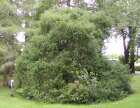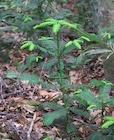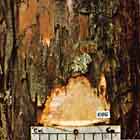Conservation Status

var. harringtonia

var. nana

subsp. wilsoniana
Cephalotaxus harringtonia
(Knight ex J. Forbes) K. Koch 1873
Common names
Japanese plum yew, イヌガヤ Inugaya [Japanese], 日本粗榧 rì běn cū fěi [Chinese], 개비자나무 gaebijanamu [Korean].
For var. nana: Dwarf Japanese plum yew, ハイイヌガヤ Haiinugaya [Japanese], 눈비자나무 nunbijanamu [Korean], 日本柱冠粗榧 rì běn zhù guān cū fěi [Chinese].
For subsp. wilsoniana: Taiwan plum yew, 臺灣粗榧 tái wān cū fěi [Chinese].
Taxonomic notes
Type: Malaysia, the Penang Mountains, represented by the illustration in Forbes (1839). Syn. Taxus harringtonia Knight ex J. Forbes (1839). This species was collected in Japan and introduced to Europe in the 1830s under the name Cephalotaxus drupacea, but that name was not validly published until 1846. Thus Taxus harringtonia had priority, and reassignment to Cephalotaxus took until 1873; nonetheless, the name C. drupacea is very common in the older literature. Initially most observations of Cephalotaxus were assigned to this species and it only gradually became apparent that it is confined to Korea, Japan, and Taiwan. This raises a puzzle: the type locality stated by Forbes (1839) is at approximately 5°N latitude, far south of any known extant Cephalotaxus species; thus the provenance of the type is unknown.
The taxon includes three infraspecific taxa which, having largely disjunct ranges and ecological settings, should be treated as subspecies, but two have only been described as varieties. The molecular analysis by Wang et al. (2022) (see Cephalotaxus) found that these varieties together form a distinct clade, sister to a clade of all other Cephalotaxus species except C. oliveri. The varieties are as follows.
- Cephalotaxus harringtonia var. harringtonia. Type, as for the species. Many synonyms, the principal ones being C. drupacea Sieb. & Zucc. var. harringtonia (Knight ex J. Forbes) Pilg (1903) and C. koreana Nakai (1930). Widespread.
- Cephalotaxus harringtonia var. nana (Nakai) Rehder (1941). Lectotype Japan, Hokkaido, Prov. Siribeshi, Takashima, August 1888, Jinzo Matsumura s.n. (TI). Many synonyms, the principal one being C. nana Nakai (1919). Japan endemic.
- Cephalotaxus harringtonia subsp. wilsoniana (Hayata) Silba 2007. Type Taiwan, Nantou, Chia-I pref., Ali Shan, K. Uyematsu 18 (holo TI). Syn. C. wilsoniana Hayata 1914, C. harringtonia var. wilsoniana (Hayata) Kitam. 1974, C. sinensis (Rehd. & E.H.Wilson) var. wilsoniana (Hayata) L.K.Fu & Nan Li 1997. Taiwan endemic.
Description
Shrubs, or small trees to 10 m tall and 40 cm dbh (but often multi-trunked); habit prostrate to erect; when erect, having a wide, open and rounded crown, usually of spreading branches but highly variable. Bark thin, exfoliating in narrow strips, gray-brown. Twigs short, slender to stout, glabrous, grooved between decurrent leaf bases, green turning orange-brown. Leaves more or less in two ranks, often upright forming a v-shaped foliar unit, especially on branches bearing pollen cones; 2.5-4 cm long, 2.5-4 mm wide, straight or downcurved towards the apex, petiole short and twisted, cuneate base, linear-lanceolate, apex acuminate or cuspidate, coriaceous, stiff, green above with two pale bands each with 10-15 intermittent lines of stomata below; upper midrib prominent, 0.5 mm wide, raised and continuous; lower midrib 0.5-0.7 mm wide, nearly flat, also continuous; leaf margins flat. Pollen cones axillary, in rows of capitula on the underside of lateral foliage twigs, each capitulum on a 3-7 mm long scaly peduncle subtended by ovate, incurved bracts with more or less hyaline margins, bearing 6-12 small, globose, nearly sessile cones 3-4 mm diameter. Microsporophylls 5-15 per cone, each with 2-3 globose, cream-colored pollen sacs. Seeds cones borne 3-6 together at base of lateral foliage twigs on 5-15 mm long slender peduncles; fertilized ovules surrounded by an obovoid green or purplish aril enclosing the seed; at maturity 15-20 × 12-18 mm, soft, orange-red to purple, smooth or with longitudinal striations. Seed (ob)ovoid to subglobose, 12-18 × 8-12 mm (Farjon 2010). See García Esteban et al. (2004) for a detailed characterization of the wood anatomy.
According to Farjon (2010), the varieties may be distinguished as follows:
- Var. harringtonia is a shrub or small tree to 10 m tall; the leaves are often borne in a V-formation, especially on shoots bearing pollen cones; leaves 3-4.5 cm × 3-4 mm, tapering to an acuminate or cuspidate apex.
- Var. nana is a shrub with upright, suckering stems and layering lower branches; the leaves are mostly horizontally arranged, and are 1-3 cm × 2-3.5 mm with an abruptly cuspidate apex.
- Subsp. wilsoniana is a small tree to 10 m tall; the leaves are mostly horizontally arranged, and are 3-5 cm × 3-4 mm, straight or slightly falcate, gradually tapering to an acuminate apex.
Distribution and Ecology
The species is distributed throughout Korea, Japan, and Taiwan. There are also reported occurrences on mainland China from about 24-31°N but this is biogeographically implausible and Farjon (2010) does not recognize the species' occurrence in China; it may have naturalized in some localities, though. Korean occurrences are reported as undifferentiated C. harringtonia but are likely all represented by var. harringtonia. Japanese occurrences are a mix of var. harringtonia and var. nana; the latter is largely restricted to very rocky sites, either near the seacoast or in the mountains. Taiwan occurrences are nearly all var. wilsoniana in the northern half of the island, and undifferentiated C. harringtonia in the southern half; var. wilsoniana occurs from 1500-3000 m elevation, so the southern occurrences should all be var. harringtonia. In general, then, var. harringtonia occurs on relatively less stressful sites, typically at lower elevations, commonly as a shrub or small tree in densely vegetated settings; in Japan it is often in the understory of forests dominated by Abies sachalinensis, or in open moorland, or in southern Japan in mixed forests with species of Abies, Quercus, Tsuga, Chamaecyparis, and sometimes Podocarpus. Var. nana occurs as a low-growing forest understory shrub, and on more stressful sites, such as on rocks near the seacoast or in the mountains at elevations up to about 1900 m (Farjon 2010); in this role it seems to be ecologically analogous to Taxus canadensis in North America. Subsp. wilsoniana is a small shade-tolerant tree that grows in the understory of mixed montane forests dominated by Fagaceae, Lauraceae, Pinaceae (Pinus, Pseudotsuga, Tsuga), and a variety of other trees. In more open situations, e.g. after forest disturbance, it can hold its own and resprout from the base or roots to form a dense bush (Yang and Luscombe 2013). Overall, this is the most cold-tolerant species of Cephalotaxus, with some provenances of vars. harringtonia and nana as hardy as USDA Zone 5 (Tripp 1995).
Distribution data, based on GBIF occurrence download https://doi.org/10.15468/dl.bz6u39 (2024.08.24). Undifferentiated C. harringtonia shown in white; var. harringtonia shown in dark brown, var. nana shown in light brown, and var. wilsoniana shown in orange. Open left pane for legend; click on any icon for a link to source information. See map notes (left pane) for details on map preparation.
Var. harringtonia is rated "Least Concern" for conservation due to a wide range and many large populations (Katsuki et al. 2013)a. Var. nana is also rated "Least Concern"; although it has a more limited range, the populations are large and the species does well in secondary (logged) forest (Katsuki et al. 2013)b. Var. wilsoniana is rated "Endangered". It has a small extent of occurrence (4,375 km²) and area of occupancy (294 km²). Although it is locally common, populations are severely fragmented, and there is continuing overall loss of habitat as a result of clearance to make way for Cryptomeria plantations. The species occurs in several protected areas, but does not benefit from any targeted conservation efforts (Yang and Luscombe 2013). These conservation assessments all date to 2010, so further declines may have occurred.
Remarkable Specimens
In 1916, the great plant-hunter E. H. Wilson reported "The largest I saw grow in the rich forests at the foot of Higashi-Kirishima [in Kyushu] ... I saw many trees from 8 to 10 m tall with ... wide-spreading branches forming broad rounded crowns" (Wilson 1916). The large New Zealand specimen shown at right was measured in 2002 as 60.6 cm dbh and 7.3 m tall. A female cultivated specimen in Seattle is 8.0 m tall (Bob Van Pelt email 2024.09.02).
Ethnobotany
Traditionally, the wood was used in Japan for items such as tool handles and household utensils; these are common uses for the wood of Taxus throughout its range, suggesting that the wood is very tough and durable. Lamp oil was also pressed from the seeds. The species also has a very long history of cultivation in Japan (Farjon 2010). I have not found similar uses documented in Korea and Taiwan, but it seems likely.
Currently, this is the most common and popular Cephalotaxus in ornamental use, with several described cultivars that vary in growth habit, shade tolerance, and cold tolerance (USDA Zones 5 to 9) (Tripp 1995). The species is occasionally harvested for timber, and is used both in traditional medicine and as a source of chemicals that have proven effective in treatment of cancer, sometimes with other medical applications (see Abdelkafi and Nay 2012 and Hao 2021 for recent reviews).
Observations
For vars. harringtonia and nana, I have no specific sites of interest, but the map shown above includes precise locations for known occurrences; iNaturalist will also be a useful resource for finding popular, easily-located occurrences. For subsp. wilsoniana, a detailed occurrence map at the Plants of Taiwan website provides many precise locations. The most interesting record to me is: Taichung Xian: Hoping Xiang: Lishan, on open roadside; at elevation 3000 m, this is the highest record for the taxon.
Remarks
Named for the Earl of Harrington, who gave a specimen to the Duke of Bedford; that cultivated plant was the basis for the 1839 description of "Taxus harringtonia". The epithet nana means "small" or "dwarfed", while the epithet wilsoniana honors the flamboyant East Asian plant-hunter Ernest Henry Wilson.
Nakai (1919), in the first description of var. nana, says "This remarkable Cephalotaxus seems to be widely distributed over Hokkaido. It was hitherto commixed with Cephalotaxus drupacea [C. harringtonia var. harringtonia] and sometimes considered to be a dwarf northern form of it. I have been in Hokkaido this summer. Going to Nopporo-forest I was astonished to find it making a pure bush under woods of Abies sachalinensis and Quercus crispula. I traced the root and found that the bush which covers certain area consists of a few stocks. Not only it branches from the base of stem, but its rhizome-like roots stretch under the ground, from which many aerial shoots come out. We tried to get young plants came out of seeds and those shoots often puzzled us. The shoots fruit when they become three feet high. Mr. Maekawa, the assistant professor of Hokkaido University who went there with me, told me that the ripen fruits are reddish and edible. We tried several half-matured ones and they taste sweet however rich of resin. We kept a number of them and they became soon red."
Citations
Abdelkafi, Hajer, and Bastien Nay. 2012. Natural products from Cephalotaxus sp.: chemical diversity and synthetic aspects. Natural Product Reports 29(8):845.
Forbes, J. 1839. Pinetum Woburnense. James Moyes, London. Available: Google Books, accessed 2024.08.25.
Hao, Da-Cheng. 2021. Biodiversity, chemodiversity, and pharmacotherapy of Cephalotaxus medicinal plants. Pp. 243-304 in Da-Cheng Hao (ed.), Taxaceae and Cephalotaxaceae. Academic Press.
Herbarium of the Research Center For Biodiversity, Academia Sinica, Taipei [HAST]. 1999. Database output at http://www2.sinica.edu.tw:8080/hast/eindex.html, accessed 1999.03.15, now defunct.
Katsuki, T., Y. Yang, and D. Luscombe, D. 2013a. Cephalotaxus harringtonii var. harringtonii. The IUCN Red List of Threatened Species 2013: e.T191567A1989524. https://dx.doi.org/10.2305/IUCN.UK.2013-1.RLTS.T191567A1989524.en, accessed 2024.08.26.
Katsuki, T., Y. Yang, and D. Luscombe, D. 2013b. Cephalotaxus harringtonii var. nana. The IUCN Red List of Threatened Species 2013: e.T191567A1989524. https://dx.doi.org/10.2305/IUCN.UK.2013-1.RLTS.T191568A1989531.en, accessed 2024.08.26.
Koch, K. H. 1873. Cephalotaxus Sieb. et Zucc. Dendrologie 2(2):102–104. Available: Biodiversity Heritage Library, accessed 2024.08.26.
Nakai, Takenoshin. 1919. Notulae ad Plantas Japoniae et Koreae XXI. Shokubutsugaku zasshi (Botanical Magazine Tokyo) 33:195. Available, Biodiversity Heritage Library, accessed 2024.08.26.
Nakai, Takenoshin. 1930. Notulae ad Plantas Japoniae & Koreae. Shokubutsugaku zasshi (Botanical Magazine Tokyo) 44:508. Available: doi.org/10.15281/jplantres1887.44.507.
Pilger, R. 1903. Taxaceae, pp. 99-105 in A. Engler, A. (ed.) Das Pflanzenreich 5 (Heft 18), 4th edition. Wilhelm Engelmann, Leipzig. Available, Biodiversity Heritage Library, accessed 2024.08.26.
Rehder, Alfred. 1941. New species, varieties and combinations from the collections of the Arnold Arboretum. Journal of the Arnold Arboretum 22: 569–579. Available: Biodiversity Heritage Library, accessed 2024.08.26.
Wang, Jie, Chao-Nan Fu, Zhi-Qiong Mo, Michael Möller, Jun-Bo Yang, Zhi-Rong Zhang, De-Zhu Li, and Lian-Ming Gao. 2022. Testing the Complete Plastome for Species Discrimination, Cryptic Species Discovery and Phylogenetic Resolution in Cephalotaxus (Cephalotaxaceae). Frontiers in Plant Science 13: 768810. https://doi.org/10.3389/fpls.2022.768810, accessed 2024.08.26.
Wilson, Ernest Henry. 1916. The conifers and taxads of Japan. Publ. Arnold Arbor. 8, Univ. Press, Cambridge, Mass. Available: Biodiversity Heritage Library, accessed 2021.12.19.
Yang, Y. and D. Luscombe. 2013. Cephalotaxus harringtonii var. wilsoniana. The IUCN Red List of Threatened Species 2013: e.T31257A2802620. https://dx.doi.org/10.2305/IUCN.UK.2013-1.RLTS.T31257A2802620.en, accessed 2024.08.26.
See also
Elwes and Henry 1906-1913 at the Biodiversity Heritage Library (as C. drupacea and C. pedunculata). This series of volumes, privately printed, provides some of the most engaging descriptions of conifers ever published. Although they only treat species cultivated in the U.K. and Ireland, and the taxonomy is a bit dated, still these accounts are thorough, treating such topics as species description, range, varieties, exceptionally old or tall specimens, remarkable trees, and cultivation. Despite being over a century old, they are generally accurate, and are illustrated with some remarkable photographs and lithographs.
Li H.L. 1953. Lloydia 16:162 (description of C. sinensis).
The species account at Threatened Conifers of the World.
Huang 1994 (the Flora of Taiwan, as C. wilsoniana).









